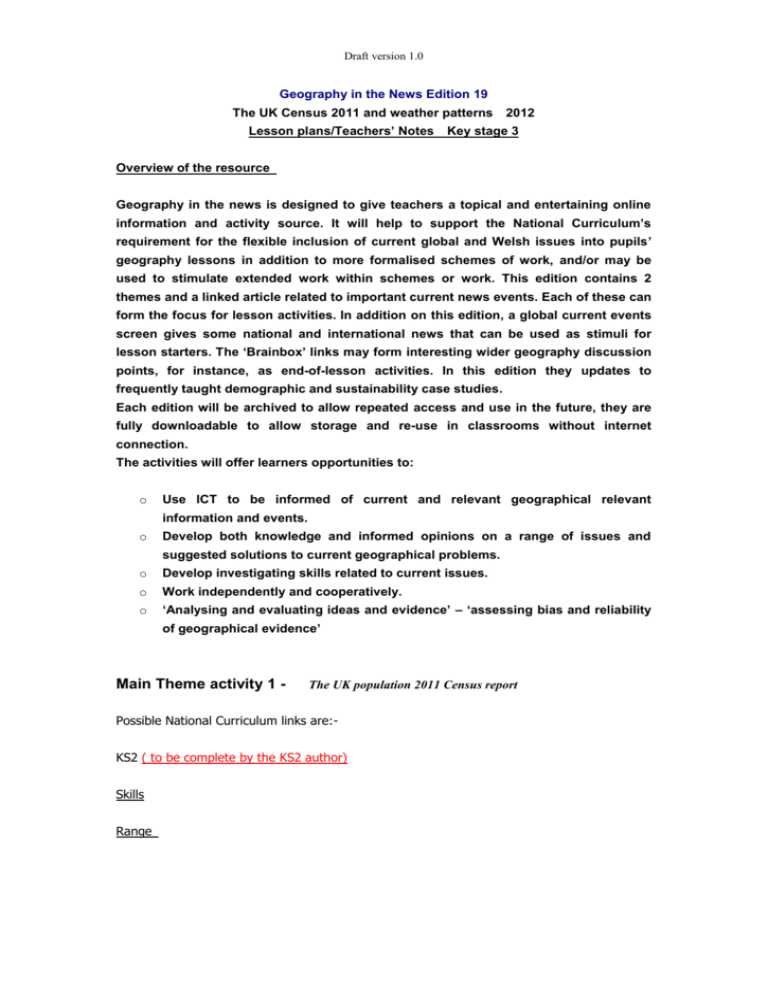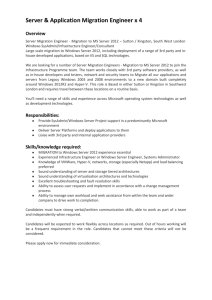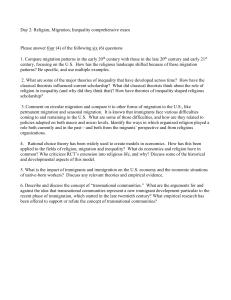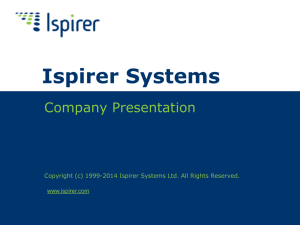Teachers Notes KS3 - Geography in the News
advertisement

Draft version 1.0 Geography in the News Edition 19 The UK Census 2011 and weather patterns Lesson plans/Teachers’ Notes 2012 Key stage 3 Overview of the resource Geography in the news is designed to give teachers a topical and entertaining online information and activity source. It will help to support the National Curriculum’s requirement for the flexible inclusion of current global and Welsh issues into pupils’ geography lessons in addition to more formalised schemes of work, and/or may be used to stimulate extended work within schemes or work. This edition contains 2 themes and a linked article related to important current news events. Each of these can form the focus for lesson activities. In addition on this edition, a global current events screen gives some national and international news that can be used as stimuli for lesson starters. The ‘Brainbox’ links may form interesting wider geography discussion points, for instance, as end-of-lesson activities. In this edition they updates to frequently taught demographic and sustainability case studies. Each edition will be archived to allow repeated access and use in the future, they are fully downloadable to allow storage and re-use in classrooms without internet connection. The activities will offer learners opportunities to: o Use ICT to be informed of current and relevant geographical relevant information and events. o Develop both knowledge and informed opinions on a range of issues and suggested solutions to current geographical problems. o Develop investigating skills related to current issues. o Work independently and cooperatively. o ‘Analysing and evaluating ideas and evidence’ – ‘assessing bias and reliability of geographical evidence’ Main Theme activity 1 - The UK population 2011 Census report Possible National Curriculum links are:KS2 ( to be complete by the KS2 author) Skills Range Draft version 1.0 KS 3 Range People and the planet population patterns change and movement Skills Explain how and why places change and identify trends and future implications eg. Population increase Explain how and why places and environments change and identify trends and future implications. Main article : Aims: After a delay of 15 months, the England and Wales 2011 census summary report was th published on June 15 , 2012. This activity provides and information summary to stimulate interest in the very clear trends in both size and age characteristics of the current demographics. (Scotland’s data will be published later in the year). Objectives: There are 3 sections in the resource :1/ an introduction - the nature and scale of the key demographic size characterisics 2/ a quiz-based analysis of national social trends and possible links with of demographic change through birth , death and migration rates. 3/ A summary of the age structure trends Activity type: st The 1 resource screens The time needed to use this resource will data content-rich vary in relation to the levels of pupil response and will require a step by step generated. A one-hour hour lesson may be presentation with allowance for a used when the teacher wishes to use the recognition of trends. opportunities are and 3 Suggested time: rd relatively for developing structured dialogue on both characteristics and causes. The 2nd screen provides a whole Draft version 1.0 class quiz based discussion resource that can stimulate some explanations for the trends identified. Lesson introduction: An approach to the activity is to reinforce what may have been learned more generally about the demography of the home region. The key stimulus is the recognition that all children and adults in the classroom are a part of the statistics and will be directly impacted by the continued changes indicated by them. Further activity opportunities The nature of the activity is to encourage discussion over the causes of the census key findings. However the impacts of the changes, including the need for policies to manage the social and economic consequences of the past and future UK. demographic change could be foci for extended work on this topic. The full resources are available from http://www.ons.gov.uk/ons/rel/census/2011-census/population-and-household-estimates-for-england-an d-wales/index.html linked article 2 : Migration in the UK Possible National Curriculum links are:KS2 ( to be complete by the KS2 author) Skills Range KS3 Range people and the planet: population patterns, change and movement Skills - Explain the causes and effects of physical and human processes -e.g. the impacts of migration in Europe Draft version 1.0 Aims: The focus for this resource is to use the 2010 and 2011 census information to show how some of the entrenched perceptions of both short and long term migration can be better informed now that the migration trends of the last decade have been quantified . Objectives: This topic is produced in the context of quite emotive and sometimes anecdotal perceptions of the UK migration issue, fired by political, media and possibly even local and domestic perception. The first objective is to differentiate between short and long-term migration. Once this has been achieved, the significance of the reversals in short term but continued concerns over the size and impact of long term migration can be highlighted. The resources are content rich Suggested time: 30 minutes to several and provide justification for the lessons, to both contextualise the resource debate over migration to and from and then use it. the UK., a presentation resource of the key migration data for the last decade and more particularly, the year of 2010-2011 . Lesson summary - Screen 1 Introduces the significance if migration in the history of the UKJ’s demographic make-up.and also acknowledged the contentious nature of the current migration issues. Screen 2 provides political references for this debate. Screens 3 and 4 Introduces the definition for an Census evidence of short-term migration Screen 5 contains the comparative information for long term migration Screen 6 is a summary statement for simple closure of the activity to emphasis that the recent figured should be used to update or replace perceptions and old classroom resources. Activity opportunities Experience in both GCSE and A level examination response has shown that learner perception of migration related issues ranges through the range of the population in general and do require an informed foundation to opinion. It is hoped that the resource can be used to raise awareness of the recent reversals in migration trends and also generate healthy debate on the wider long term political , moral and economic issues associated with the consequences of migration to and from the UK. Draft version 1.0 Activity 3 The UK weather, Stuck in a Rut Possible National Curriculum links are:KS2 ( to be complete by the KS2 author) Skills Range KS3 Range The physical world and processes and landforms Skills - The physical World - and the Hazardous world , extreme / hazardous events Aim: To develop learners’ knowledge of the complex causes of recent, very evident and newsworthy meteorological characteristics Objectives: The focus of this resource is to summarise in as simple a way as possible, the key features of the northern hemisphere upper air circulation and to show how the recent changes in flows have led to much more extreme meteorological events. Activity type: Information presentation Suggested time: of a complex meteorological system from 15 minutes to 1 hours depending on level of detail and consequent discussion simplified for Key stage 3 use Lesson introduction: Any lesson that encourages learner anecdotal experience of the last 7 months of weather in the home region and then use this step-by-step exposition of the causes as a learning resource. Some of the steps will require careful and elaborated clarification for some learners ,but the complex components of the system are sufficiently simplified for most KS3 learners to grasp both the causes and consequences of the jet stream weather’engine’ Activity opportunity : Draft version 1.0 This resource is designed to support and enhance schemes of work which already contain meterological studies . It is however quite possible that a autumnal timed ‘summer’ review could use this resource as a one-off explanation for learners who ask why the weather has been so extreme recently and also, whether the events mark a short or long term change and related to global warming?







